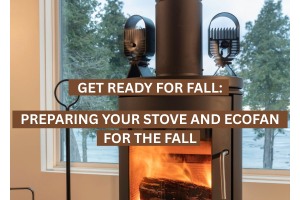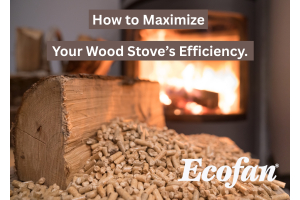How to Maximize Your Wood Stove’s Efficiency

A wood stove is more than just a source of heat—it’s the heart of your home during the colder months. But to truly get the most from it, you need to ensure it’s operating at peak efficiency. From choosing the right fuel to placing your fan in the optimal spot, small adjustments can make a big difference in warmth, fuel savings, and environmental impact.
In this guide, we’ll walk you through practical tips to help you maximize your wood stove’s efficiency, whether you’re a new stove owner or a seasoned pro.
Choose the Right Fuel
Not all wood is created equal. Using the wrong fuel can waste heat, create excess smoke, and damage your stove over time.
- Hardwoods (oak, maple, ash) burn longer and produce more heat per log.
- Softwoods (pine, fir) ignite faster and are ideal for kindling but burn more quickly.
- Always use seasoned wood—logs that have been dried for at least 6–12 months. This reduces moisture content, resulting in hotter, cleaner burns.
Pro Tip: Invest in a moisture meter to ensure your firewood’s water content is below 20%.
Perfect Your Fan Placement
A stove fan is a simple but powerful tool for heat distribution—but only if it’s positioned correctly.
- Place your fan on the hottest part of your stove’s surface so it can push warm air into the room.
- Avoid placing it near stove pipes or cooler areas where airflow may be less effective.
- If your fan is eco-powered, ensure it’s positioned for maximum exposure to heat so it spins efficiently.
Why it matters: Proper fan placement can significantly improve room-wide heat circulation, reducing cold spots and ensuring your fire’s heat works harder for you.
Maintain Proper Airflow
A wood stove needs oxygen to burn efficiently. Without enough airflow, you’ll get cooler burns, more smoke, and wasted fuel.
- Keep vents clean and unobstructed.
- Use the damper to fine-tune burn rate—open for more heat quickly, closed slightly for longer burns.
- Never completely close your air supply while the fire is burning.
Keep Your Stove Clean
Buildup inside your stove can block airflow and absorb heat that should be warming your home.
- Remove ash regularly (but leave a thin layer to protect the firebox base).
- Clean stove glass to keep an eye on your flame quality.
- Have your chimney swept at least once per season to remove creosote.
Load Your Stove Correctly
The way you load wood impacts burn quality.
- Place larger logs at the back and smaller logs/kindling in front.
- Avoid overloading—too much wood restricts airflow.
- Try the “top-down burn” method for cleaner ignition: larger logs on the bottom, smaller logs above, kindling and firestarter on top.
Maximizing your wood stove’s efficiency is all about smart fuel choices, strategic fan placement, proper airflow, and regular maintenance. Not only will these tips help you get more heat from less wood, but they’ll also extend the life of your stove and reduce your environmental footprint.
Stay warm, burn smart, and enjoy every cozy moment by the fire.






